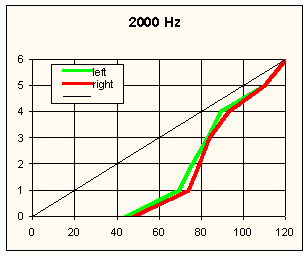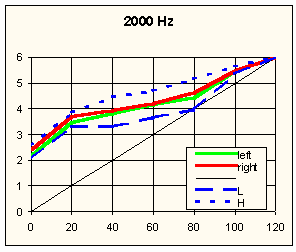Employing Fuzzy Logic and Noisy Speech
for Automatic Fitting of Hearing Aids
Bozena Kostek1,2 bozenka@sound.eti.pg.gda.pl
Andrzej Czyzewski2 andcz@ieee.org
1Institute of Physiology & Pathology of Hearing
Pstrowskiego 1
01-912 Warsaw, Poland
2Technical University of Gdansk
Sound & Vision Engineering Department
Narutowicza 11/12, 80-952 Gdansk, Poland
http://www.akustyka.com/
http://www.telewelfare.com/
Popular version of paper 2pPP10
Presented Tuesday Afternoon, December 4, 2001
142nd ASA Meeting, Fort Lauderdale, FL
SUMMARY
In this paper some limitations of the hearing-aid fitting process are discussed. In the fitting process, an audiologist performs tests on the wearer of the hearing aid, which is then adjusted based on the results of the test, with the goal of making the device work as best as it can for that individual. Traditional fitting procedures employ specialized testing devices which use artificial test signals. Ideally, however, the fitting of hearing aids should also simulate real-world conditions, such as listening to speech in the presence of background noise. Therefore, more satisfying and reliable fitting tests may be achieved through the use of multimedia computers equipped with a properly calibrated sound system. We have developed a new automatic system for fitting hearing aids. It employs fuzzy logic. In this process, a computer makes choices for adjusting the hearing aid's settings by analyzing the patient's responses and answering questions with replies that can lie somewhere between a simple "yes" or "no." This paper will describe the method and present some results of the experiments conducted to test the system.
HEARING_AID_FITTING_STRATEGY_PRINCIPLES
Communication is essential for a properly functioning society.
Hearing disorders are often a cause of communication problems. They can affect
quality of life of persons with hearing loss. That is why the proper fitting
of a hearing aid is a very important part of the recovery process for people
with hearing problems. However, adequate fitting of a hearing aid depends on
the experience of the patient's doctor as well as the capabilities of the testing
equipment which enable audiologists to adjust the hearing aid. On the other
hand, computer technology makes it practical to organize such tests based entirely
on computer software.
There exist several limitations in the traditional clinical process of fitting
hearing aids. Paradoxically, this is mainly due to the rapid progress of technology
in the hearing-aid field. One can observe not only a change from analog to digital
technology but also hearing device miniaturization, improved speech signal processing,
better directional characteristics, etc. On the other hand the fitting process
and the follow-up procedures typically remain the same as previously used, thus
more sophisticated methods are needed. In addition, clinical assessment uses
artificial signals; thus this process is far from the everyday settings in which
hearing aids are used. It is especially true for people with hearing loss trying
to communicate in noisy environment. This can dramatically increase the number
of problems that a hearing aid user will encounter. The fitting procedures might
be also long and tiring for a patient. Therefore there is a need to develop
new strategies in hearing-aid fitting procedures and the supporting technology.
A satisfying fitting strategy can be achieved through the use of modern multimedia
computer technology with application of a properly calibrated sound system.
In the paper a new strategy that allows finding automatically characteristics
of a hearing aid matching patient's needs is shown briefly. The principles of
the fitting method, some details of the devised system design, and results of
experiments are also presented. back
HEARING AID FITTING STRATEGY PRINCIPLES
The proposed hearing aid fitting strategy employs a computer-based system. Apart from the computer a pair of properly calibrated earphones is used in testing [Ref_2][Ref_3]. The earphones of choice are insert-type (in-ear) models. This is to partially overcome the problem of impedance mismatches between the artificial cavity of the headphones and the ear. These earphones and the computer sound interface were calibrated using the artificial-ear setup.
A potential user of the system starts with the examination of loudness-growth characteristics in 4 frequency bands (a so-called Loudness Growth in ½ Octave Bands - LGOB procedure [Ref_1]). In the loudness growth test a patient listens to the sound (a narrow-band noise) and the task is to evaluate his/her impression of loudness using such expressions as: too loud, very loud, loud, comfortable, soft, very soft, too soft. Sounds of various levels are presented to the patient in a random order, and each sound sample is presented to the patient a few times in order to eliminate mistakes. Then, these subjective responses are translated to levels in decibels (dB). Characteristics of a person with a hearing loss can be seen in Fig_1a.
These characteristics are especially important in the case of patients with sensorineural hearing loss, because increasing hearing aid gain up to the amount of loss results in too much amplification. This is because of the much lower dynamics in the impaired hearing sense. In short, lower dynamics means that a person with a hearing loss after linear amplification doesn't hear soft sounds, whereas sounds of a moderate level are perceived as very low ones, and loud sounds may be perceived as too loud. On the other hand, typical responses of a person with normal hearing will be such as in Fig. 1, but lying approximately on the diagonal of the diagram.
Based on these characteristics it is possible to generally classify the case of hearing impairment represented by a given patient. These characteristics allow also finding the shape of proper compressor characteristics. This situation is illustrated in Fig_1b. Characteristics obtained in this way are used by the proposed system to simulate needed hearing aid performance. However, the standard method of measuring loudness growth characteristics employs filtered noise, whereas only the understanding of speech amidst noise can provide a final criterion for proper hearing aid fitting. Unfortunately, there are no means of direct mapping of standard loudness growth characteristics measured by noise to the characteristics corresponding to the compressed noisy speech understanding. That is why the empirical testing procedure should employ assessment of the level of understanding of speech patterns processed using adequately diversified compression curves (see the blue dashed lines in Fig_1b). The diversification of these curves can be decided by the system. The interest region for diversifying these curves is defined according to the evaluated degree of the hearing impairment. The principle of this evaluation can be as simple as that: the deeper the impairment, the wider is the interest region of diversified compression curves. However in our system the interest region is established employing a fuzzy logic-based reasoning and a so-called "computing with words" approach [Ref_4][Ref_5][Ref_6].


Fig. 1. Exemplary loudness impression testing results for left and right ear representing the expansion characteristics (a), and dual characteristics constituting the compression curves that should be used for the processing of sound in suitable hearing aids (b). The interest region of compression curves is marked in dashed lines, representing its low and high boundaries. X-axes represent sound level, Y-axes reflect the subjective loudness level back_1
After the loudness impression characteristics are obtained for
a given patient, and processed by the fuzzy logic engine, the system performs
speech pattern testing. Speech signal is passing through four partially overlapping
filter bands with the following middle frequencies are: 500, 1000, 2000 and
4000 Hz. The signal dynamics are modeled in each band on the basis of sound
compression characteristics. The processed signal is played back into the patient's
headphones. The system stores 600 phonetically balanced audio-video recordings
of simple sentences based on colloquial language. They are read partly by a
female and by a male speaker. The patient listens to the recordings randomly
chosen by the system during the test. The system shows synchronized video recordings
of speakers' faces. This feature is needed for deeply hearing impaired patients
who are capable of lipreading and allows assessment of lipreading influence
to speech understanding.
After a single recording is played back and then received by the patient, the
text of the sentence is shown on the screen. The patient self-estimates the
level of understanding of the recording just played back using the established
subjective assessment scale. Once the tests are completed the system analyzes
the scores assigned by the patient to individual patterns played back.
On the basis of the results the system presents optimized dynamic characteristics
of the hearing aid matching patient's needs.
back
In this paper a new strategy for testing hearing with the use
of an expert multimedia system has been outlined. This system may be helpful
to properly diagnose patients and to give them some kind of sound experience
before the hearing aid is selected for them. The hearing characteristics are
assessed using the modified loudness scaling test. Since the compression curves
derived from testing with filtered noise usually differ from compressor settings
desired for optimal speech understanding, a special procedure has been established
allowing for finding a region of interest for testing compression characteristics
with processed speech patterns. Consequently, this region of interest is determined
on the basis of extended loudness scaling test. The modification of the hearing
aid fitting procedure lies in the introduction of fuzzy logic principles to
the processing of results of testing loudness impression with filtered noise
samples. The fuzzy processing of patients' responses employs membership functions
identified by normally hearing population and in this way the degree of impairment
for an individual is discovered.
The proper compression characteristics that should be used in the hearing aid
of concrete patient are tested finally by speech patterns in order to optimize
further speech understanding.
back